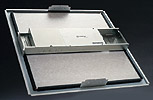People working in office buildings, especially in the increasingly common open-space, cubicle-filled architecture, gripe most often about being too hot or too cold and having too much noise around them. But two companies that have tried to change that by giving employees more control over their personal workspace environment through applied technology have met with mixed results.
 |
| WIRELESS LEARNING All students at Terrace can see at once. (Photo courtesy of ©Armstrong World Industries Inc.) |
Johnson Controls Inc., Milwaukee, Wis., was first to tackle the issue back in 1988 with its Personal Environment Modules. PEMs allow employees to control air temperature and flow, lighting and noise masking from their desks. The company is just now bringing the price down to what some think is a more affordable level for wider adoption. First introduced at a cost of about $2,000 per unit, the systems now are about $700 per unit in higher volume purchases.
Despite heavy promotion and offers to install the units for free to get the ball rolling, Johnson Controls expects to sell only 3,000 units this year. "It's not taking the world by storm and we always thought it would," says company spokesman Steve Thomas. "We're still waiting for that breakthrough to happen."
While not addressing the temperature control problem, Armstrong Building Products, Lancaster, Pa., has joined the sound-control effort. Last year, it rolled out its innovative i-ceilings Sound Systems, as well as i-ceilings Wireless Systems for voice and data. A multidisciplinary team at Armstrong tasked with coming up with new ideas for the ceiling plane devised the idea of integrating several functions invisibly into one ceiling panel. Time from concept to product debut was just 18 months. The sound system so far is on target with sales projections, but the voice and data wireless product is lagging, say company officials.
The sound system embeds sound masking, paging and background music into one ceiling panel. Everything but paging was new for Armstrong. The masking feature produces a blanket of "white noise," giving cubicle-dwellers more privacy and quiet. Typically these functions are separate systems and are plenum-based.
 |
| MASKED PANEL Three functions are hidden in one normal-looking ceiling panel. (Photo courtesy of ©Armstrong World Industries Inc.) |
Masking and background music are delivered straight down, which gives broader, more consistent sound than traditional plenum-based systems. In those systems, speakers hung from the deck send sounds upward, which then bounce back downward, cone-style, and "have to fight their way through a ceiling panel that's designed to block sound in the first place," says William Willis, Armstrong marketing technician.
The panels take less time to install than traditional sound systems, says Brian Keith Gross, president of Wavecrest Systems, Leesburg, Va., which has installed them in more than 1 million sq ft of Nextel call centers and offices across the U.S. He says the shallow space required for installation and the flexibility of being able to move the panels virtually at will are attractive features.
Mechanical-electrical engineer Newcomb & Boyd installed i-ceilings in its new office in Atlanta housing 150 people in January, before recommending them to others. Despite some initial resistance from employees, the "sound masking has been working just fine," says Karl Peterman, head of the acoustics team. "It's a good thing to have in any open office."
The i-ceilings' wireless systems eliminate unsightly, dangling "pipe-bomb" antennas and hide everything in the ceiling panels. Students at Terrace Community School, Tampa, link laptop computers wirelessly to the Web via i-ceilings. "We can have 80-some students on line at one time," says Bill McKelligott, principal. "We literally have mobile labs."
However, sales of the i-ceilings Wireless Systems are lagging somewhat, admits Gregg Maberry, general manager of new businesses for Armstrong and head of the wireless business. "The question is not whether wireless is going to be a way to distribute data within a building�it's when," he says. Unsettled standards and regulations, carriers focused on squaring away their own networks and users' speed and security questions all hurt, he says. "The challenge we have here is to be patient," he adds. Maberry says that Armstrong is committed to both i-ceilings products and has more new, out-of-the-box businesses in development.
The General Services Administration's Adaptable Workspace Lab in Washington, D.C., contains both PEMs and i-ceilings sound systems. Lois Bennett, designer and co-project manager, says she's seen "mixed results" with the PEMs."We definitely think [PEMs] have a use, but I don't know that they really achieved what the person was hoping for," Bennett says.
Feedback on i-ceilings is not yet available, as they were only recently installed in the GSA laboratory.

Post a comment to this article
Report Abusive Comment